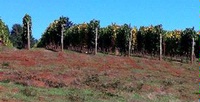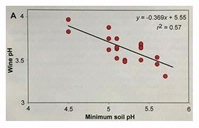|
|
 |


When wine sellers tell the stories behind the wines they present, they frequently wax poetic about the soil from which the grapes are drawn. Statements about wines being grown, variously, on limestone, granite, sandstone, clay, alluvium, colluvium, volcanic rock and on and on are made with great emphasis and certitude that they mean something – something really important. Generally, when you question further, you don’t find a scientific reason why the touted soil type is meaningful, just that it is different. A host of questions then besets the curious mind regarding the reasons that might underlie the long-standing axiomatic superiority of the noted soil type. This is the way wine is spoken about and sold in many establishments that sell the bottles.
Wine as a category can be frustrating to the science-minded. While some of the parameters that surround wine are clearly understood, many more can only be guessed at. For instance, we know that grape sugars are turned to alcohol and carbon dioxide by the action of yeast cells. While the beginning and end points of the sugar to alcohol reaction are known, it is the compounds other than ethanol that give a wine distinction, and those can be present in miniscule quantities that have a pronounced effect on the wine. The cascade of chemical reactions that occurs during the fermentation process can be moved in different directions by any number of variables.
When we move into the vineyard, the scientific challenge becomes even greater. Now, we must consider variations throughout the growing season as well as harvest time decisions and weather variability. Even in the face of this formidable uncertainty, science carries on. A recent article in GSA Today entitled “The effects of soil on the taste of wine” by Gregory J. Retallack and Scott F. Burns attempts to place a more solid scientific underpinning on what has hitherto been the stuff of tradition and local agricultural wisdom and lore.
Let’s first explore how science is conducted generally, then look at the specifics of the Retallack & Burns paper. The scientific method is an ongoing process by which scientists strive to explain the phenomena that we observe in the world around us. It is, at its basis, a 4-step process that can quickly become complex if we permit our study to wander away from a central premise.
The first order of business is to observe a process or phenomenon
Second, we form a hypothesis to explain what we have observed
Third we use our hypothesis to predict the result of an experiment crafted to test the tenets of our hypothesis
Fourth, we conduct an experiment. We analyze the result of our experiment to determine if it agrees with our prediction. On the basis of experiment, we can accept or reject our hypothesis.
We can use deductive as well as inductive reasoning in our experimentation. In deductive reasoning, we propose a hypothesis and make a prediction of its consequences. We go from the general to the specific and reason what the observations should be if the hypothesis is correct. Inductive reasoning approaches the scientific task from the other direction – the specific to the general. Here, we make observations and strive to understand a pattern. From our observations, we develop a hypothesis. Then, we can create experiments to accept or reject that hypothesis.
Keep in mind there is nothing final about our experiment, even if it produces results that agree with our prediction. Our experiment was a first step, one that must be replicated by others. An underlying principle to scientific exploration is that a hypothesis can only be proven wrong. It can never be proven right, since future experiments may reveal factors that were not realized until that moment. It is best, when conducting experiments, to limit the variables to only one. That allows the scientist to evaluate the impact of a single variable on the process. With wine, however, this is not possible. While one can strive to minimize the variables, there are far too many to control completely.

Basalt based Jory type soil in the Dundee Hills
Getting back to the study, Retallack and Burns endeavored to evaluate the impact of soil on wine in the Willamette Valley of Oregon. While one of the confounding elements of the experiment is the inherent variability of soil profiles, the authors divided soil types into three types: the Jory silt loam, based on weathered basalt; soils like Willakenzie type, based on marine sediments; and more recent soils based on wind-blown loess and river-deposited valley fill sediments.
To limit their variables, the authors studied only Pinot Noir wines, only from the Willamette Valley AVA. The wines were grouped by vintage for consistency across harvests. The authors measured several parameters: the maximum and minimum pH of the soil; pH of the grape juice and wine; depth to the base of a soil clay horizon; harvest quantity; seasonal rainfall; soil clay content; soil organic content; soil cation exchange capacity and qualitative evaluation of the finished wines by the wine industry. They compiled data from web-posted technical sheets from 177 Willamette Valley wineries to analyze wine parameters (alcohol, acidity, etc.).

Sedimentary, Willakenzie-type soil in the Yamhill-Carlton District
The most significant result of the study was a confirmation of some long-standing grower knowledge. They found an inverse relationship between minimum soil pH and wine pH. That is, as the soils became more alkaline, with their minimum pH ranging from 4.4 to 5.5, the wines from those soils showed a drop in pH values from 3.9 to as low as 3.3. Thus, Pinot Noirs produced on low minimum pH soils like the basalt-based Jory series produce wines with rounded complex character. Wines from more recent, higher minimum pH soils yielded wines with lighter, more tart characteristics and lower pH values.
The authors tested several variables against each other – wine pH vs. maximum soil pH; wine pH vs. soil clay content; wine pH vs. soil cation exchange capacity and, significantly, found no statistically valid relationship. Too, the study showed no relationship between wine pH and grape Brix values, wine total acidity, alcohol content, price per bottle or harvest date.

Inverse Relationship between Minimum Soil pH and Wine pH
It’s pretty clear why so many students avoid science courses like the plague. The pursuit of science involves large numbers of small studies like this one. Our understanding of the world is built upon these blocks of experimental knowledge – tested and retested until we have confidence that our hypotheses are confirmed. It only takes a bit of thought, however, to realize that wine, from the vineyard to the bottle, involves far too many variables to define very closely in a scientific sense. Even if we did know everything about a wine today, everything would change just a little bit by tomorrow and we would need to start again. Fortunately, we don’t need to fully understand the science in order to appreciate the winemaker’s art.
|
 |
|